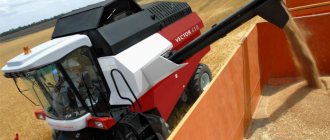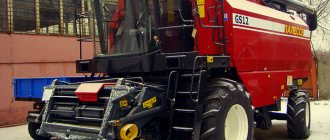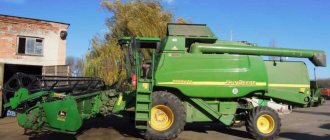Agriculture in Russia continues to be a subsidized industry. But experts are already predicting high profits for the agricultural sector of our economy if small farms and large agro-industrial complexes are able to find resources to modernize agricultural production. The main need is modern special machinery and equipment. In this case, the interests of the country's leading agro-industrial complexes completely coincide. But in Rostov they focus not only on the domestic market. The plant plans to actively develop international cooperation. However, the oversaturated global trading platform requires exclusivity. The RSM 161 combine harvester should be such an option.
The novelty of the idea lies in the modular design, the basis for which is a large-scale platform. In general, the new development belongs to class 7. But the idea of modular architecture makes it possible to design combines of different performance levels and, accordingly, greater or lesser class.
Giant's cabin
The tour of the combine begins in the operator's cabin. The design of the workplace, its level of comfort, and the controllability of a machine of such a high-tech category are of no small importance. The cabin area of the RSM 161 combine allows the driver and two passengers to comfortably accommodate. A sprung chair can rival an executive's office chair in terms of comfort. The similarity is added by the presence of a shock-absorbing suspension and high low-pressure wheels, which smooth out the jolting effect from bumps and vibrations. The presence of air conditioning is mandatory. This saves the combine operator from the tedious midday heat that accompanies the entire harvest period. Operating the RSM 161 combine does not require special skills, but, of course, the driver is obliged to bring a number of operations to automaticity. The steering wheel must be rotated with your left hand only. The right one is on the joystick. With its help, the combine starts moving, moves forward and backward, and performs other functions. Here, on the joystick, there are keys that regulate the movement of the attachment. All information about the status of equipment and main units is displayed on the display.
Technical characteristics of "RSM-161" in numbers
- Overall dimensions, in working and/transport condition: length – 11.43/19.3 m; width – 9.5/3.93 m; height 4.95/3.95 meters.
- The size of the header is 6, 7 or 9 meters.
- Base length – 3.78 meters.
- The track width is 3.14 m (equal for both the front and rear tracks).
- Ground clearance – 450 mm.
- Working areas: separation – 8 sq.m; cleaning – 6 sq.m.
- The speed of movement of the knives is 1180 strokes per minute.
- Base weight without refueling 21.4 tons; without header and transport trolley - 17.9 tons.
- Individual weight of the units: header – 1,890 kg; pick-up – 920 kg; transport trolley – 1,400 kg.
- The volume of the diesel fuel tank is 1,050 liters.
- The internal volume of the bunker is 10.5 cubic meters.
- The speed of movement across the field during work is from 8 to 11 km/h. Transport – up to 20.5 km/h.
- The width of the thresher is 1650 mm.
- The diameter of the threshing drum is 800 mm (+750 mm – separator).
- Number of scourges – 10.
- Drum rotation frequency – 300-920 rpm; with gearbox – 395-11500 rpm.
- Concave area – 1.83 sq.m.; with separator – 3.3 sq.m.
- The concave coverage angle is 124 degrees.
- Straw walker – 6-key, 5-step.
- Key separation area – 6.1 sq.m.
- Cleaning area – 7.1 sq.m.
- The volume of the grain tank is 10.5 thousand liters.
- The rotation angle of the auger is 105 degrees.
- The maximum unloading height is 5.05 meters.
- Unloading speed – 115 liters per second, grain with moisture content up to 35%.
- Auger length – 6.723 m.
We recommend reading: YaMZ 238 engine: technical characteristics
Manufacturers draw the attention of potential buyers to the fact that the RSM-161 combine harvester is good within the framework of machine-technological stations. Its transport dimensions are such that it does not require a special escort vehicle when traveling on public roads. Although, of course, in our country this requirement is not observed as unquestioningly as in Europe.
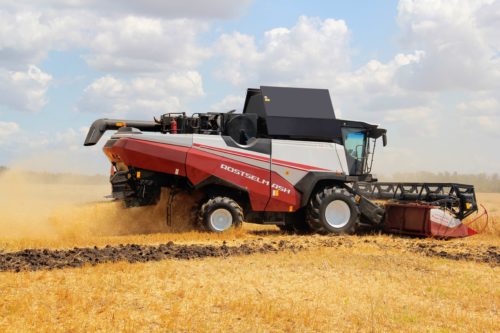
Fuel consumption indicators
Diesel fuel "RSM-161" consumes within different limits, depending on the work it performs. In particular,
- when harvesting cereal crops, the consumption is about ten liters of diesel fuel per hectare of area, which is equivalent to 2.46 kg per ton of grain.
- When harvesting sunflowers, 4.6 liters of diesel fuel are consumed per 1 hectare of area. Converted to a ton of final collected product, this consumption is 1.74 kg.
- The highest fuel consumption is obtained when harvesting corn and is equal to 13.2 liters per hectare.
Drum component
The Rostselmash production site houses a full set of industrial equipment that allows the creation of special-purpose agricultural equipment from scratch. A separate space is provided for the location of a number of bulky conveyors on which the combines are assembled. The principle of operation of any combine is to cut the ears, knock out the grain from them, and clean the grain with the supplied air flow. These functions are performed by a rotating multifaceted reel, which straightens the growing ears of corn and directs them to the cutting mechanism. The cut ears fall into the auger, where they turn into an illegible grain mass. Its flow moves into the inclined chamber, is leveled and in this form is received by the thresher. The drum harvester design, traditional for domestic special-purpose agricultural machinery, consists of the drum itself, including threshing whips. Their design is almost no different from the ancient flails that were once used to manually beat grain from ears of corn. The RSM 161, unlike conventional combines, is equipped with two drums. Each of them is equipped with two units of auxiliary equipment. Thus, due to the simultaneous operation of a pair of drums, the giant’s productivity more than doubles. The grain grower receives maximum threshing in the shortest period of time. This is an important factor when harvesting is carried out both day and night in order to capture good weather and eliminate possible grain losses.
Place of "RSM-161" in the plant's product line. Purpose of the model
According to the plan, it is designed to fill the intermediate market segment between the popular classes of heavy combines - a promising market niche between Akros and Torum. According to one of the creators of RSM-161, Dmitry Inozemtsev, “back in 2009 it was obvious that there was a gap in our model range; we did not have a car for this market segment. And up to a thousand units of combine harvesters were sold there every year!”
Large grain-sowing peasant farms in Russia are now on the rise and need powerful and productive equipment. That is why in recent years there has been an increase in the demand for rotary machines. At the same time, due to difficult agro-climatic conditions (in particular, high humidity and weeds), many agricultural enterprises still prefer push-button combine harvesters.
Of course, Western-made combines are very powerful and comfortable; They are distinguished by high build quality and a solid margin of safety. But they are also very expensive. And, in addition, they are very difficult to maintain, demanding on the quality of diesel fuel, spare parts are expensive and are not always available. This is why consumers tend, in most cases, to choose domestic products.
We recommend reading: Excavator EO-3322: technical characteristics
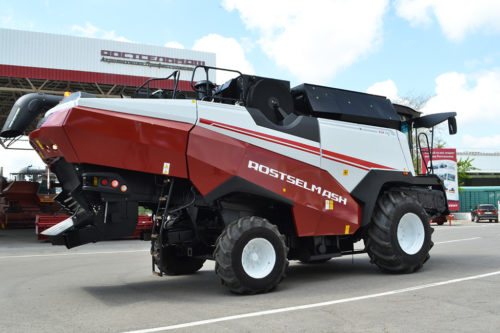
The new RSM-161 combine is a 2-drum, 6-key machine. A few years ago, in its absence, Rostselmash specialists proved that a single-drum machine is optimal for harvesting grain. But now a 2-reel drum is also being produced. The advantage of a 1-drum combine is its willingness to compromise. This is a car, so to speak, for all occasions. But the approach is changing in accordance with modern requirements. After all, in fact, there are no universal machines, in the full sense of the word.
Two drums are especially effective in conditions of high humidity in combination with medium to high yields and requirements for straw quality, when there is an intention to save it for feed. The Rostov manufacturer is gradually moving away from the concept of a “universal product”, as from the legacy of a bygone era, in which farmers were content with no alternative. Potential buyers, who have become more solvent and demanding in recent years, are presented with differentiated offers.
"RSM-161" is intended for harvesting all classic grain crops: cereals and cereals, oilseeds and legumes, row crops. A high-performance machine, which is capable of processing up to two thousand hectares at the end of the season, produces up to forty tons per hour of regular time.
In general, there are three basic schemes of two-drum combines: accelerator-drum-beater; drum-beater-separator; drum-beater-separator-beater. The third option was implemented in the RSM-161 design.
RSM-161 combines mow, pick up cereal grains or other crops with further threshing, separation, and grain cleaning. Cleaned grain is accumulated in a bunker and then unloaded into storage tanks. After collecting food, he cleans up non-grain residues - he chops and scatters straw throughout the field. Or it can leave the straw intact during harvesting. The harvesting process is allowed on a flat field with a slope of up to 8 degrees in the main grain-sowing zone.
Rotary harvester TORUM
Rostselmash did not stop at narrow specialization in drum threshing schemes. The company is successfully mastering another mechanism, embodied in the TORUM rotary combine. Instead of a drum, a massive rotating rotor is used. Threshing of grain is carried out due to the action of centrifugal force and rubbing of the grain mass by the rotor deck. The Rostovites managed to patent their own production scheme, which is based on the simultaneous operation of three threshing points. The result is a multiple increase in productivity. But there is a so-called side effect. Firstly, the rotary device of the combine crushes the straw, making it subsequently unsuitable for livestock farming. Secondly, the effect of its operation is significantly reduced when working in climatic conditions with high humidity, where fields are characterized by a high degree of weeds. The rotary TORUM breaks all records in well-groomed areas in the south of Russia and Western Europe. For other regions, RSM-161 is intended to be a real salvation. Despite difficult climatic factors and difficult terrain, the double-drum giant will perform the work with the highest quality. Even when processing the harvested crop, losses are minimized due to the low degree of grain crushing. Accepted standards allow for a 2 percent crushing level. RSM-161 indicators do not exceed 0.5%. That is 4 times lower. But at the same time productivity is reduced. RSM-161 produces 45 tons of grain, while the rotary TORUM successfully processes 60 tons.
Threshing and separating device "RSM-161"
The RSM-161 has a progressive threshing system called Tetra Processor. The compressed mass enters the threshing drum after acceleration and leveling of the feeder chamber with a beater to a speed of 8.5 m/s. The threshing drum is heavy, large in diameter, and has high inertia. Gives a tangible advantage when working on difficult backgrounds.
The working bodies are spaced at an optimal distance. Their layout ensures a smoother (compared to the compact packaging of MSU working bodies) and extended trajectory of the heap movement, stability and efficiency of the process, minimizing damage to grain and straw.
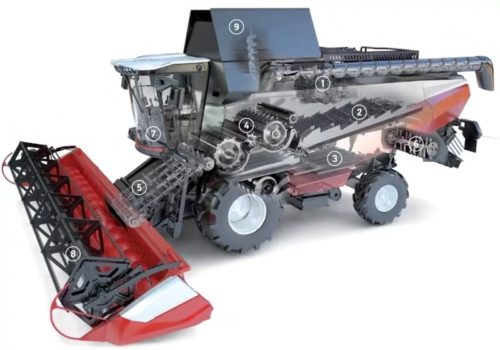
At the main threshing stage, up to 70% of the grain is separated. Another 20-25% is on the transport beater and separator drum. The unthreshed ear enters the autonomous rotary after-threshing device, preventing possible overload of the threshing and separating device. “Tetra Processor” and the autonomous after-threshing device provide up to 90-95 percent of grain separation before the heap is supplied for further cleaning.
We recommend reading: Forza walk-behind tractor (9 hp): owner reviews
The Tetra Processor device has a flexible deck with automatic electronic clearance control throughout its entire length. Huge threshing and separation area of 3.3 square meters. (total – 9.4 sq.m.), ensures an intensive separation process with minimal damage to grain and straw, including on the most difficult agricultural backgrounds. The device width of 1,650 m allows the harvester to achieve a productivity of up to 40 tons per hour of main time.
